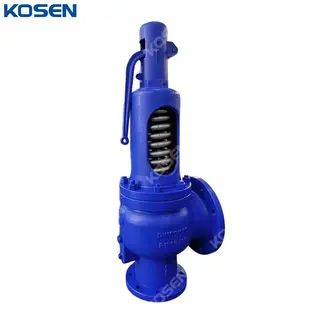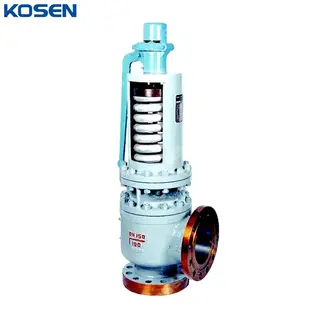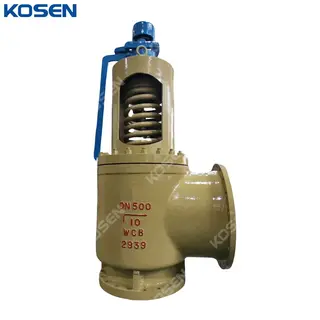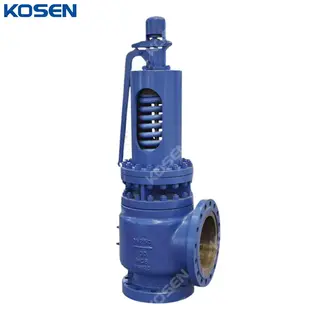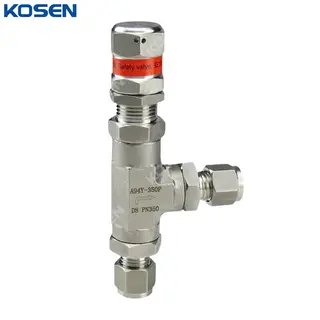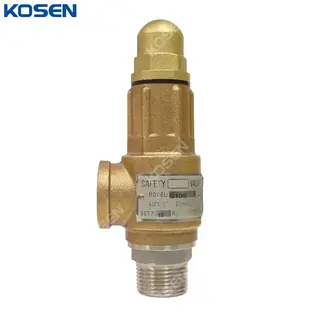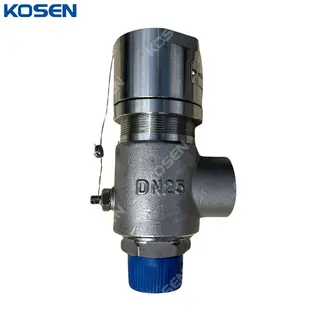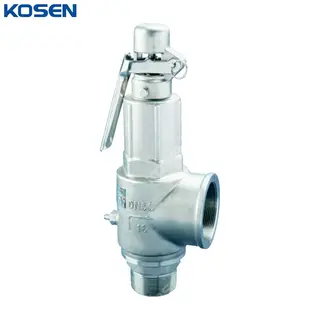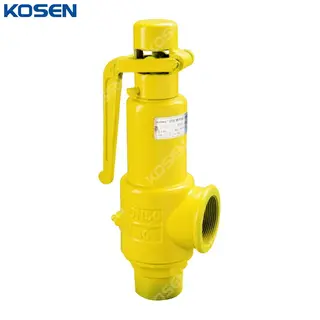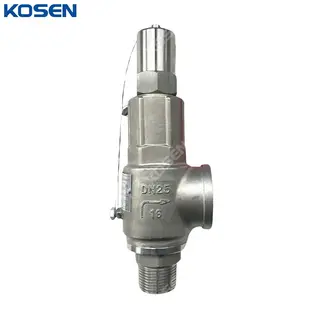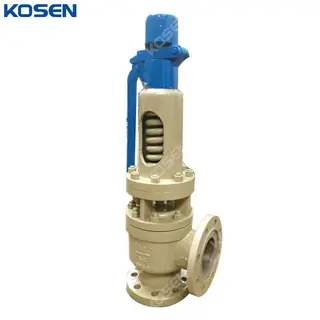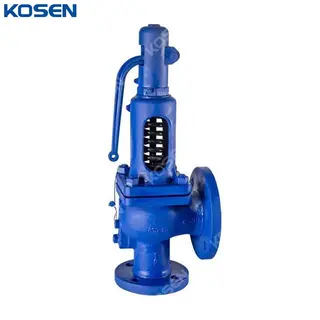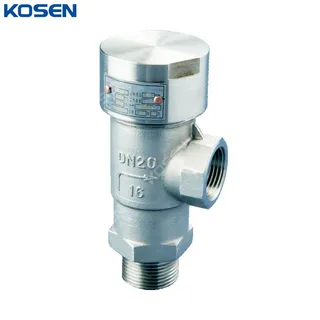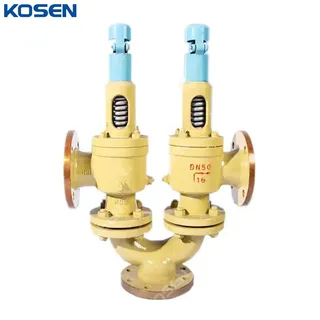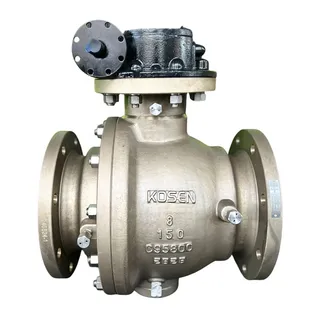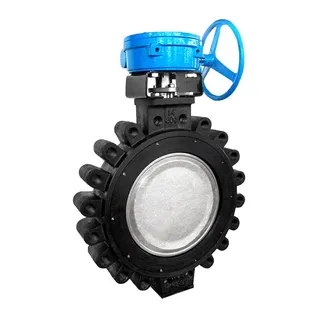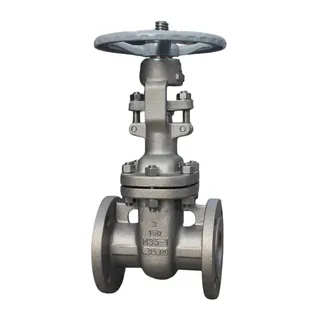A safety valve is a crucial safety device designed to prevent internal pressure from exceeding safe limits, protecting pipelines and containers from damage caused by excessive pressure. Safety valves operate based on several primary principles, including spring-loaded, lever-operated, and pilot-operated (pulse-type) safety valves.
The weighted lever safety valve uses a combination of a weight and a lever to balance the force applied to the valve disc. Utilizing the principle of leverage, even a small weight can generate a large force through the lever effect. By adjusting the weight's position or changing its mass, the opening pressure of the valve can be easily and flexibly adjusted. This type of valve is simple in structure, easy to adjust, and accurate, making it widely used in high-temperature environments such as boilers and pressure vessels. However, its bulky structure is susceptible to vibrations, which may lead to leakage, and its low reseating pressure and difficulty in fast closure can affect its sealing performance.
The spring-loaded micro-opening safety valve balances the force on the valve disc using the compression of a spring. The spring's compression can be adjusted by turning the adjustment nut on the spring, allowing for the regulation of the valve's opening pressure. This type of valve is compact, highly sensitive, and less sensitive to vibrations, making it suitable for mobile pressure vessels. However, as the valve disc rises, the spring's compression increases, which can impact the valve's ability to open quickly. Additionally, the spring may lose its elasticity under prolonged high-temperature exposure, requiring heat insulation or cooling measures, increasing the complexity of the valve.
In a spring-loaded full-opening safety valve, the opening height is at least one-quarter of the flow path diameter, with the discharge area equal to the minimum cross-sectional area of the valve seat throat. This type of valve operates in two stages and requires a lifting mechanism to fully open. It is primarily used for gas applications.
The pulse-type safety valve consists of a main valve and an auxiliary valve. The auxiliary valve's pulse action drives the opening of the main valve. This safety valve is complex in structure and is typically used in boilers and pressure vessels where large safety discharge volumes are required.
The pilot-operated safety valve relies on the medium discharged from a pilot valve to control the action of the main valve. The pilot valve is typically a direct-acting safety valve, although other valve types may also be used. Pilot-operated safety valves are suitable for high-pressure, large-diameter applications, and their main valves can be designed to rely on the working medium for sealing or use larger mechanical loads compared to direct-acting safety valves to improve sealing performance. The advantage of this valve type is that its action is less affected by back pressure. However, its reliability depends on both the main and pilot valves, and it operates less quickly and reliably than direct-acting valves. The structure is also more complex.
The direct-acting safety valve operates by directly using the pressure of the working medium on the valve disc to overcome the mechanical load of the spring and open the valve. This valve type has the advantages of simple structure, quick action, and good reliability. However, due to its reliance on mechanical loading, its load capacity is limited, making it unsuitable for high-pressure or large-diameter applications.
The selection of safety valves is based on factors such as medium type, operating conditions, pressure, and temperature. Common selection scenarios include:
Steam Boilers: Open full-opening spring-loaded safety valves are used for overpressure protection in steam applications, while micro-opening spring-loaded safety valves are used for precise fluid control in liquid applications.
Gas Applications: Full-opening spring-loaded safety valves are commonly used for gas (e.g., air) due to their high discharge capacity. For LPG trucks or rail tankers, full-opening internal spring-loaded safety valves are used for compact design suitable for gas storage and transport.
Oil Well Exits: Pilot-operated safety valves are used for high-pressure situations and provide excellent sealing. High-pressure bypass safety valves for steam power generation equipment should have dual functions of safety and control to ensure stable system operation.
Routine Opening Tests: For routine opening tests, safety valves with lifting wrenches should be selected for ease of checking the valve's opening flexibility.
High-temperature Media: For high-temperature media (over 300°C for closed safety valves or 350°C for open safety valves), safety valves with heat dissipaters are required to reduce the temperature inside the spring chamber.
Back Pressure Changes and Corrosive Media: If back pressure exceeds 10% of the opening pressure, a bellows safety valve should be used for reliable sealing. For corrosive media, bellows safety valves prevent failure of critical components due to corrosion.
Gas, Steam, and Liquid Discharges: For gas or steam discharge, full-opening safety valves are chosen for their large discharge capacity. For liquid discharge, either full-opening or micro-opening safety valves can be used. For high-temperature gases, safety valves with heat dissipators prevent spring erosion by the discharge medium.
Medium Discharge Requirements: For mediums allowed to discharge to the atmosphere, open bonnet safety valves are selected. For media that cannot discharge to the atmosphere, closed bonnet safety valves are preferred.
Toxic, Highly Corrosive, and High Back Pressure Situations: For discharging toxic, highly corrosive, or extremely hazardous media, bellows safety valves are used. In high back-pressure environments, back pressure balanced or pilot-controlled safety valves are recommended for stable operation.
Spare Safety Valves: In critical situations, safety valves that serve as spares should be installed with mechanical interlocks to ensure the container's discharge needs are met at all times.
The installation of safety valves must adhere to specific principles to ensure proper operation and safety. Key installation requirements and precautions include:
Installation Location: Safety valves should be installed vertically and as close as possible to the protected equipment or pipeline. The installation position should allow for easy maintenance and adjustment, with sufficient surrounding space.
Pressure Vessel Safety Valves: Safety valves on pressure vessels are typically installed above the liquid level in the vapor space of the vessel or on pipelines with connection points located in the vapor space. For containers or equipment with flammable, toxic, or viscous media, a shut-off valve can be installed before the safety valve, but the shut-off valve's flow area must be at least the same as the minimum flow area of the safety valve and should be sealed with lead seals to ensure the shut-off valve remains fully open.
Clogging Prevention: For safety valves that may be clogged or corroded by materials, burst discs can be installed before the valve, along with check valves between the burst disc and the safety valve. Anti-clogging measures such as back flushing, heat tracing, or insulation should also be implemented.
Fluid Pressure Stability: When installing safety valves on pipelines, they should be placed in areas with stable fluid pressure, away from sources of pressure fluctuations, and not at dead spots in horizontal pipes.
Discharge Outlet Design: For emergency discharges, the outlet pipe should be smooth, free from sharp edges, and burr-free to prevent static discharge. The safety valve's discharge pipe should avoid excessive backpressure and remain within the allowed range.
Support and Stability: The valve body should be stably supported to ensure stability during operation.
Discharge Pipe Design: When multiple safety valves share a discharge pipe, the pipe's cross-sectional area must be at least the total cross-sectional area of all the safety valve outlets. However, gases such as oxygen, combustible gases, and others that may react chemically should not share a discharge pipe. For extremely hazardous or flammable media, the discharge should be routed to a safe location and appropriately treated.
Safety valves may experience various faults during long-term operation, and prompt identification and handling of these issues are essential to ensuring system reliability. Common faults and solutions include:
Leakage: Caused by mechanical damage or corrosion of the sealing surface. Solution: Repair the sealing surface by grinding or turning. Severe cases require replacing the sealing surface or components.
Spring Failure: Caused by excessive load or corrosion. Solution: Replace the spring.
Bent Stem or Misaligned Disc: Caused by stem bending or improper alignment of the disc and seat. Solution: Reassemble or replace the stem, disc, or related parts.
Lever Misalignment: Caused by misalignment between the lever and pivot point. Solution: Correct the lever's centerline.
Incorrect Opening Pressure: Caused by improper adjustment or overlooking the working medium's characteristics and temperature. Solution: Re-adjust the safety valve, but avoid more than three adjustments.
Sealing Surface Contamination: Caused by medium contamination or crystallization. Solution: Blow out the valve or grind the disc and seat if severe.
Excessive or Insufficient Spring Compression: Caused by improper adjustment or maintenance. Solution: Re-adjust the spring-loaded safety valve to ensure proper compression.
Valve Not Fully Opening: Caused by excessive nominal pressure, high spring stiffness, or high friction. Solution: Re-select the safety valve or clean and replace parts.
Improper Discharge Pipe Setting: Caused by excessive resistance in the discharge pipe. Solution: Adjust the pipe to reduce resistance.
Disc Vibration: Caused by excessive discharge volume or resistance in the inlet pipeline. Solution: Re-select the safety valve to match the system, or adjust the inlet pipeline and reduce discharge pipe resistance.
Safety valves play a critical role in various industries, preventing equipment failures or explosions due to excessive pressure and ensuring the safe operation of equipment. Major applications include:
Petrochemical Industry: Used to protect reactors, pipelines, and pressure vessels from overpressure, ensuring the safe transport and storage of oil and gas.
Power Generation: Used to protect boilers, steam turbines, and pressure vessels from excessive pressure, ensuring the safe operation of power plants.
Food and Beverage Industry: Used in pressurized systems to prevent contamination and ensure the safety of food processing systems.
Pharmaceutical Industry: Used to protect equipment in drug manufacturing, ensuring safe conditions during production processes.
